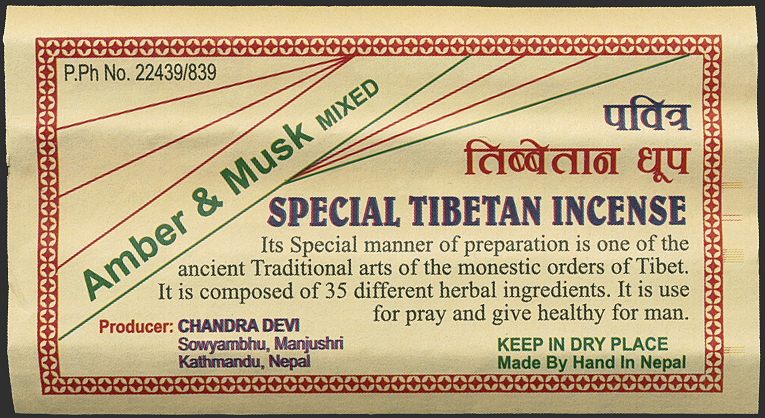A Detour Into Tibetan Incense
[Update: 2025-02-28 – price corrected]
I use the term “Tibetan incense sticks” as a collective term; the sticks can also come from Nepal or Bhutan, but are very similar in style.
My excursion into the realms of Tibetan incense began at the end of 2021. As is often the case, I read a lot about it on Reddit r/Incense and became curious.
I have read repeatedly about Tibetan incense sticks being an “acquired taste”, i.e. a taste that you have to learn, so to speak. It is rare that people like Tibetan incense sticks straight away. In general, they just smell like smoke at first, for most people.
I was curious to see whether I would feel the same way, or to what extent I would be able to determine the development of my sense of smell based on them. I was also generally curious about the style itself.
Tibetan incense sticks are said to be very natural. It is ritual incense in which the focus is on the effect and the correspondence of the ingredients contained, not primarily on the scent.
However, there are also differences in quality with Tibetan incense sticks; those that are authentically made in Buddhist monasteries and “mass-produced” ones that are produced with a lot of filler and/or inferior ingredients. These often come from Nepal or India, or so I’ve heard.

I bought this roll from Dragonspice.de in 2021 for €4.20. It contains 45 sticks measuring 18cm, with a weight of about 60g.
The manufacturer Chandra Devi seems to be at the higher end of the spectrum of mass-produced Tibetan incense sticks.

Chandra Devi – Amber & Musk
A scent like Amber & Musk (two favourites of mine) might be the best way to start, I thought.
Except for a faint, sweet note, I actually didn’t smell anything other than smoke. This wasn’t biting or unpleasant, but it was still just smoke.
What I found very surprising was that the sticks only gave off minimal smoke. In fact, I caught myself a few times checking to see if the stick was still smouldering, so little smoke is sometimes visible.
I gave them a few tries and then lost interest.
Around this time, a Redditor from Germany made me an offer to swap samples, but he is a die-hard fan of Tibetan incense sticks and the only ones I could offer him to swap were these Amber & Musk. He said they were definitely too sweet for him.
It took me more than a year to get the Amber & Musk out again. In the meantime, I had bought the Drizang Kuenchap below and also received the sample sticks from the Traditionnel Relaxation listed below as part of another sample exchange.
I just wanted to light Amber & Musk again before putting them in the box of things to give away, and lo and behold, they suddenly smelled sweet to me. I kept them for the time being.
When I burn it today I smell a soft, sweet but still smoky aroma. It’s pretty simple and not particularly potent, which isn’t a bad thing. They give the room a warm atmosphere that even remains in the after-smell.

Lhawang Driden – Drizang Kuenchap
This pack was a lucky find on Kleinanzeigen.de. They were sold by someone who apparently travels to Bhutan often and then brings back incense sticks from the monasteries.
Such incense sticks are practically impossible to find in Germany. The only online store (worldwide) that I know of that has them is Incense-Traditions.ca in Canada, which specializes in this type of incense. A roll of the 22cm long incense sticks costs US$13.95. One pack contains 30 sticks and weighs just under 80g. They are made in Bhutan from more than 30 ingredients. There is an ORS review of Drizang Kuenchap in which Mike mentions saffron, clove, nutmeg, rhododendron, sandalwood and frankincense as possible ingredients.
Of Mike’s possible list of ingredients, the rhododendron resonates with me the most. Coincidentally, I had been sent a sample of rhododendron leaves with an order from Jarguna a while before. I find its smell to be herbaceous, herbal tea-like, with slightly floral notes.
But the smell of these sticks is far more complex than this.
The scent profile of Drizang Kuenchap has a distinct sourness that reminds me of fermentation smell, particularly lactic acid.
This acidity mixes with an underlying sweetness to create a fruity smell. Overall, the scent remains rather herbaceous, woody and slightly tart.

I love the colour of these sticks; this mat, blue tinted burgundy.
In the scent, I find a hint of the “ironing smell” that I mentioned in other reviews, which seems to come from saffron. In this case, it is specifically “ironed linen”. Furthermore, Drizang Kuenchap creates a strange association with soldering flux fumes; a smell that I unfortunately like despite knowing how unhealthy it is.
It’s been a while since I last burned these sticks. In my perception, their natural smokiness seems to have moved further into the background, and I’m starting to pick up a subtle, floral note.
Drizang Kuenchap also produces relatively low smoke for the thickness (4mm) of the sticks, only shortly before the stick goes out, when the last bit of the stick turns into embers, a noticeable white plume of smoke rises.
The after-smell retains a lot of the aroma of as it burns, but unfortunately also contains a small amount of what I find to be a rather unpleasant smoke smell.

Les Encense Du Monde – Encens Tibétan – Traditionnel Relaxation
I got these two sticks at the beginning of 2023 during an incense stick exchange. On the Aromandise website, juniper, wood and herbs are listed as ingredients. One pack contains 28 sticks of 23cm length, each of which burns for 60 minutes. They cost €5.90, but are marked as “not available”.
The lack of smoke is noticeable with those as well.
Juniper always creates an association with smoked ham for me, and that’s the case here too. It is a tart, aromatic wood smoke smell, with the characteristic sweet-tart juniper note. The smell for me is rather dry but soft. Only if you get a little too close to the smoke does it appear a little scratchy.
As long as the sticks are burning, I find the smell relatively unobtrusive, but in the after-smell there is a really unpleasant note of cold smoke.
Conclusion:
Tibetan incense sticks are not my thing, and that probably won’t ever change. Nevertheless, it is interesting for me to engage with them.
I’m not really tempted to further explore the genre actively, i.e. to look for and buy rarities like Lhawang Driden, especially since they’re so hard to find here and are usually expensive. However, if the opportunity to sample arises, I will certainly be happy to take it. In this spirit, the sticks from my collection will eventually be passed on as samples as well.
For the interested and the bargain hunters, I’ll link the current offer of the Kleinanzeigen seller from whom I bought Lhawang Driden – Drizang Kuenchap. They put new ones for offer a while ago. To anyone reading this outside of Germany: please keep in mind that this is a private sales site, and they likely won’t do international shipping.

